The New Straits Times is an English-language newspaper published in Malaysia. It is Malaysia's oldest newspaper still in print, having been founded as The Straits Times on 15 July 1845. It was relaunched as the New Straits Times on 13 August 1974. The paper served as Malaysia's only broadsheet format English-language newspaper.
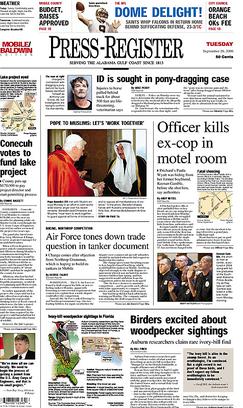
The Press-Register was a newspaper serving the southwest Alabama counties of Mobile and Baldwin. The newspaper is a descendant of one founded in 1813, making the Press-Register Alabama's oldest newspaper. It is owned by Advance Publications, which also owns the primary newspapers in Birmingham, Alabama and Huntsville, Alabama. The Press-Register had a daily publication schedule since the inception of its predecessors in the early 1800s until September 30, 2012, when it and its sister papers reduced printing editions to only Wednesday, Fridays and Sundays.

The Times-Picayune/The New Orleans Advocate is an American newspaper published in New Orleans, Louisiana. Ancestral publications of other names date back to January 25, 1837. The current publication is the result of the 2019 acquisition of The Times-Picayune by the New Orleans edition of The Advocate in Baton Rouge, Louisiana.

Hurricane Katrina was a devastating Category 5 Atlantic hurricane that caused 1,836 fatalities and damage estimated between $97.4 billion to $145.5 billion in late August 2005, particularly in the city of New Orleans and its surrounding area. At the time, it was the costliest tropical cyclone on record, later tied by Hurricane Harvey of 2017. Katrina was the twelfth tropical cyclone, the fifth hurricane, and the third major hurricane of the 2005 Atlantic hurricane season. It was also the fourth-most intense Atlantic hurricane to make landfall in the contiguous United States, gauged by barometric pressure.
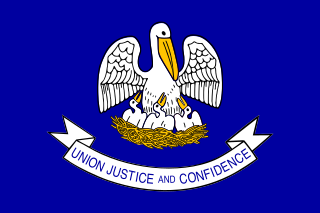
Criticism of the government response to Hurricane Katrina was a major political dispute in the United States in 2005 that consisted primarily of condemnations of mismanagement and lack of preparation in the relief effort in response to Hurricane Katrina and its aftermath. Specifically, there was a delayed response to the flooding of New Orleans, Louisiana.

The disaster recovery response to Hurricane Katrina in late 2005 included U.S. federal government agencies such as the Federal Emergency Management Agency (FEMA), the United States Coast Guard (USCG), state and local-level agencies, federal and National Guard soldiers, non-governmental organizations, charities, and private individuals. Tens of thousands of volunteers and troops responded or were deployed to the disaster; most in the affected area but also throughout the U.S. at shelters set up in at least 19 states.

This article contains a historical timeline of the events of Hurricane Katrina' on August 23–30, 2005 and its aftermath.
Aaron Francis Broussard is a former American politician who served as the president, a combined municipal-parish position, of Jefferson Parish, Louisiana, from 2003 to 2010. A Democrat, Broussard became known nationally for appearances he made in the aftermath of Hurricane Katrina.

Hurricane Katrina struck the United States on August 29, 2005, causing over a thousand deaths and extreme property damage, particularly in New Orleans. The incident affected numerous areas of governance, including disaster preparedness and environmental policy.
The Times is a Gannett daily newspaper based in Shreveport, Louisiana. Its distribution area includes 12 parishes in Northwest Louisiana and three counties in East Texas. Its coverage focuses on issues affecting the Shreveport-Bossier market, and includes investigative reporting, community news, arts and entertainment, government, education, sports, business, and religion, along with local opinion/commentary. Its website provides news updates, videos, photo galleries, forums, blogs, event calendars, entertainment, classifieds, contests, databases, and a regional search engine. Local news content produced by The Times is available on the website at no charge for seven days.
The Daily Gamecock is the editorially independent student news organization of the University of South Carolina. It primarily serves the main campus of the University of South Carolina System in the state of South Carolina.
The Donegal Democrat is a twice-weekly local newspaper, covering County Donegal, Ireland. The paper was traditionally based in the town of Ballyshannon in the south of the county, but now has offices in Donegal Town and Letterkenny. The Donegal Democrat is the largest paper focused solely on County Donegal, and its current managing editor is Chris Ashmore. The paper was the only one published in south Donegal from the mid-twentieth century on, and so has gained a reputation of being the local paper of record for that part of the county.
Gambit is a New Orleans, Louisiana-based free alternative weekly newspaper established in 1981.

The Meridian Star is a newspaper published in Meridian, Mississippi. Formerly a daily newspaper, it switched to a triweekly format in 2020, publishing on Tuesday, Thursday, and Saturday mornings. The paper covers Lauderdale County and adjoining portions of western Alabama and eastern Mississippi. It is owned by Community Newspaper Holding, Inc.

Internally displaced persons in the United States are people from the Gulf States region in the southern United States, most notably New Orleans, Louisiana, who were forced to leave their homes because of the devastation brought on by Hurricane Katrina in 2005 and were unable to return because of a multitude of factors, and are collectively known as the Gulf Coast diaspora and by standard definition considered IDPs. At their peak, hurricane evacuee shelters housed 273,000 people and, later, FEMA trailers housed at least 114,000 households. Even a decade after Hurricane Katrina, many victims who were forced to relocate were still unable to return home.
The Huntsville Times was a thrice-weekly newspaper published in Huntsville, Alabama. It also served the surrounding areas of north Alabama's Tennessee Valley region. The Times formerly operated as an afternoon paper, but moved to mornings years after The Huntsville News ceased publication. It was published by The Huntsville Times Company, Inc., a subsidiary of Advance Publications, Inc. The paper was first acquired by Advance's founder, Samuel Newhouse Sr., in 1955. The Times is a sister paper to two other Advance-owned publications within Alabama, The Birmingham News and the (Mobile) Press-Register.
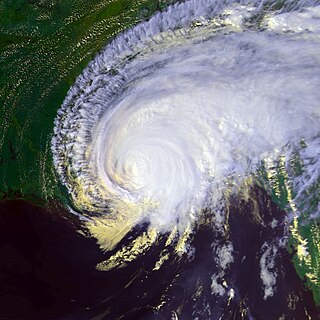
The effects of Hurricane Georges in Louisiana included $30.1 million in damage and three deaths. Forming from a tropical wave over the Atlantic Ocean, Georges attained a peak intensity of 155 mph (249 km/h) on September 20, 1998. Over the following several days, the storm tracked through the Greater Antilles and later entered the Gulf of Mexico on September 28, the Category 2 storm made landfall in Mississippi before dissipating on October 1. Before landfall, about 500,000 residents in Louisiana evacuated from low-lying areas. The mayor of New Orleans declared a state of emergency to allow federal assistance into the state. After nearly 1.5 million people were urged to evacuate coastal areas, officials described the evacuation as "probably the largest [...] we have ever achieved".
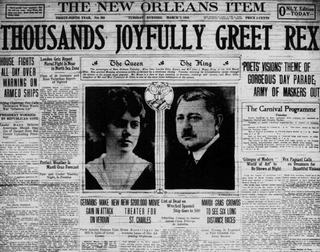
The New Orleans Item-Tribune, sometimes rendered in press accounts as the New Orleans Item and Tribune, was an American newspaper published in New Orleans, Louisiana, in various forms from 1871 to 1958.

In August 2016, prolonged rainfall from an unpredictable storm resulted in catastrophic flooding in the state of Louisiana, United States; thousands of houses and businesses were submerged. Louisiana's governor, John Bel Edwards, called the disaster a "historic, unprecedented flooding event" and declared a state of emergency. Many rivers and waterways, particularly the Amite and Comite rivers, reached record levels, and rainfall exceeded 20 inches (510 mm) in multiple parishes.
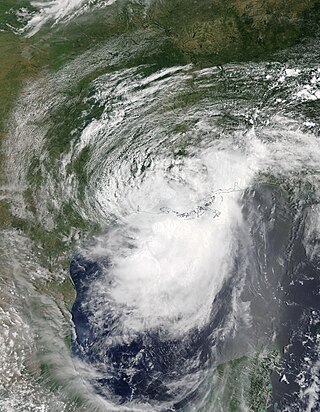
Hurricane Barry was an asymmetrical Category 1 hurricane that was the wettest tropical cyclone on record in Arkansas and the fourth-wettest in Louisiana. The second tropical or subtropical storm and first hurricane of the 2019 Atlantic hurricane season, Barry originated as a mesoscale convective vortex over southwestern Kansas on July 2. The system eventually emerged into the Gulf of Mexico from the Florida Panhandle on July 10, whereupon the National Hurricane Center (NHC) designated it as a potential tropical cyclone. Early on July 11, the system developed into a tropical depression, and strengthened into a tropical storm later that day. Dry air and wind shear caused most of the convection, or thunderstorms, to be displaced south of the center. Nevertheless, Barry gradually intensified. On July 13, Barry attained its peak intensity as Category 1 hurricane with 1-minute sustained winds of 75 mph (120 km/h) and a minimum central pressure of 993 millibars (29.3 inHg). At 15:00 UTC, Barry made its first landfall at Marsh Island, and another landfall in Intracoastal City, Louisiana, both times as a Category 1 hurricane. Barry quickly weakened after landfall, falling to tropical depression status on July 15. The storm finally degenerated into a remnant low over northern Arkansas on the same day, subsequently opening up into a trough on July 16. The storm's remnants persisted for another few days, while continuing its eastward motion, before being absorbed into another frontal storm to the south of Nova Scotia on July 19.